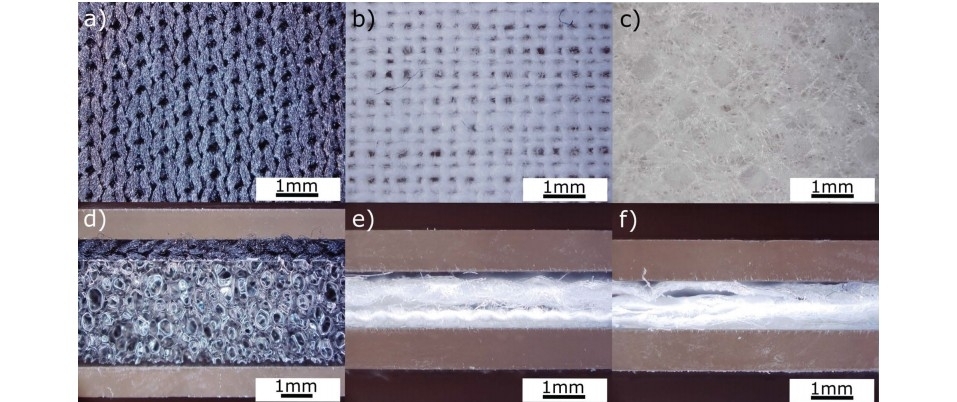

Models for professional use were the most effective at retaining aerosol particles of a size equivalent to the novel coronavirus, followed by TNT masks sold in drugstores. The efficacy of fabric masks ranged from 15% to 70%. A tight fit and lack of seams enhanced protection (digital microscope image of different face masks made of hybrid material; Fernando G. Morais et al./Aerosol Science and Technology)
Models for professional use were the most effective at retaining aerosol particles of a size equivalent to the novel coronavirus, followed by TNT masks sold in drugstores. The efficacy of fabric masks ranged from 15% to 70%. A tight fit and lack of seams enhanced protection.
Models for professional use were the most effective at retaining aerosol particles of a size equivalent to the novel coronavirus, followed by TNT masks sold in drugstores. The efficacy of fabric masks ranged from 15% to 70%. A tight fit and lack of seams enhanced protection.

Models for professional use were the most effective at retaining aerosol particles of a size equivalent to the novel coronavirus, followed by TNT masks sold in drugstores. The efficacy of fabric masks ranged from 15% to 70%. A tight fit and lack of seams enhanced protection (digital microscope image of different face masks made of hybrid material; Fernando G. Morais et al./Aerosol Science and Technology)
By Karina Toledo | Agência FAPESP – The novel coronavirus is transmitted mainly via inhalation of saliva droplets or respiratory secretions suspended in air, so that face covering and social distancing are the most effective ways to prevent COVID-19 until enough vaccines are available for all. In Brazil, fabric masks are among the most widely used because they are cheap, reusable and available in several colors or designs. However, this type of face covering’s capacity to filter aerosol particles of a size equivalent to the novel coronavirus can vary between 15% and 70%, according to a study conducted in Brazil by the University of São Paulo (USP).
The study was supported by FAPESP, and the principal investigator was Paulo Artaxo, a professor in the university’s Physics Institute (IF-USP). It was part of an initiative called (respire! to assure access to safe masks for the university community. The results are reported in an article in the journal Aerosol Science and Technology.
“We appraised the filtration efficacy of 227 models sold by drugstores and other common types of store in Brazil to see how much genuine protection they afford the general public,” Artaxo told Agência FAPESP.
The scientists conducted a test using a device that contained a sodium chloride solution and emitted aerosol particles of 100 nanometers. SARS-CoV-2 is about 120 nanometers in diameter. A burst of aerosols was triggered, and particle concentration was measured before and after the mask.
As expected, surgical masks were most effective in the test, as were the FFP2 or N95 models certified for professional use, filtering 90%-98% of the particles. Next came masks made of non-woven fabric (TNT) or polypropylene and sold in many kinds of store, with an efficiency of 80%-90%, followed by those made of ordinary cotton, spandex or microfiber, which filtered 40% on average (15%-70%).
Several factors were critical in enhancing or reducing the degree of protection. “Generally speaking, masks with a central seam protect less because the sewing machine makes holes that increase the passage of air. A tightly fitting top edge improves filtration significantly. Some masks made of fabric include fibers of nickel, copper or other metals that inactivate the virus and hence protect the wearer more effectively. There are even electrically charged models that retain more particles. In all cases, however, efficacy drops when the mask is washed because of wear and tear,” said Fernando Morais, first author of the article. Morais is a PhD candidate at IF-USP and a researcher at the Nuclear and Energy Research Institute (IPEN), an agency of the São Paulo State Government.
Breathability
According to Artaxo, dual-layer cotton masks filtered considerably better than single-layer models, but efficacy was hardly altered by a third layer, which reduced breathability.
“The study innovated in several ways. One was its evaluation of breathability or resistance to air passage,” Artaxo said. “TNT and cotton masks were best in this regard. The FFP2 and N95 models were not as comfortable, but paper masks were the worst. This is important because if a person can’t bear wearing a mask even for five minutes, it’s useless.”
The authors of the article note that although mask efficacy varies, all types help reduce transmission of the virus, and mask-wearing in conjunction with social distancing is fundamental to control the pandemic. They advocate mass production of FFP2/N95 masks for distribution free of charge to the general public. This “should be considered in future pandemics”, according to Vanderley John, penultimate author and coordinator of (respire!, which is organized by USP’s Innovation Agency.
“Transmission of the virus is demonstrably airborne and wearing a mask all the time is one of the best prevention strategies, as well as leaving doors and windows open to ventilate rooms as much as possible,” Artaxo said.
The article “Filtration efficiency of a large set of COVID-19 face masks commonly used in Brazil” can be retrieved from: www.tandfonline.com/doi/abs/10.1080/02786826.2021.1915466.
Republish
The Agency FAPESP licenses news via Creative Commons (CC-BY-NC-ND) so that they can be republished free of charge and in a simple way by other digital or printed vehicles. Agência FAPESP must be credited as the source of the content being republished and the name of the reporter (if any) must be attributed. Using the HMTL button below allows compliance with these rules, detailed in Digital Republishing Policy FAPESP.





